Introducción
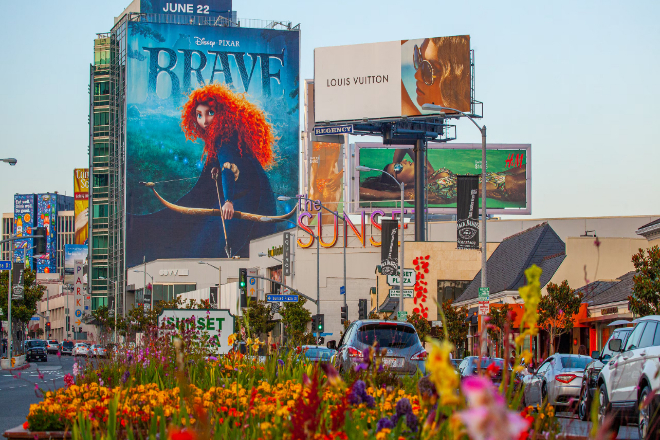
From traditional paper media, radio, and television to today’s Internet and mobile applications, the diversified development of advertising media has provided a broader space for brand communication.
Entre ellos, pantallas de visualización LED, as an emerging advertising medium, have gradually emerged in the field of wall advertising with their unique performance. So, what are the applications of LED display screens in wall advertising?
1. Analysis of traditional forms and limitations of wall advertising
1). The main forms of traditional wall advertising
- Graffiti:
Graffiti is a relatively primitive form of wall advertising, which draws advertising content on the wall by hand-painting. Although this form is artistic and personalized, it is difficult to produce and is easily affected by weather and environment.
- Spray painting:
Spray painting is a more common form of modern wall advertising. Spray painting machines are used to spray advertising patterns on the wall.
Spray painting advertising has the advantages of delicate pictures, bright colors, and realistic images, but the production cost is relatively high, and the wall requirements are high.
- Sticker:
Sticker advertising is pasting printed advertising stickers directly on the wall. This form is simple to make and low-cost, but it is easy to be damaged, easy to fall off and has a certain degree of destructiveness to the wall.
2). Limitations of traditional wall advertising
- Poor visual effects:
Traditional wall advertising has certain limitations in visual effects. For example, graffiti advertising may affect the aesthetics due to uneven hand-painting levels; sticker advertising may fade and fall off due to poor sticker quality. In addition, some wall advertisements are shoddy in design and too glaring in color, which not only fails to attract consumers’ attention but also may damage the local visual environment.
- Difficult to update:
It is difficult to update and replace the content of traditional wall advertising when the position is fixed.
For example, graffiti advertising needs to be repainted, and spray-painted advertising needs to be repainted, which not only increases the production cost but also affects the communication effect of the advertisement.
Especially in some important commercial areas or tourist attractions, frequent replacement of wall advertisements may have adverse effects on the local environment.
- Environmental damage:
Traditional wall advertising may cause damage to the wall and the environment during the production process. For example, sticker ads may leave glue marks or damage the wall surface when they are torn off.
Spray-painted ads may have a negative impact on the ecological environment due to the use of environmentally unfriendly paints and materials. In addition, some wall ads may have problems, such as random graffiti and irregular posting, which seriously affect the overall aesthetics of the city.
2. What are the applications of LED display screens in wall ads?
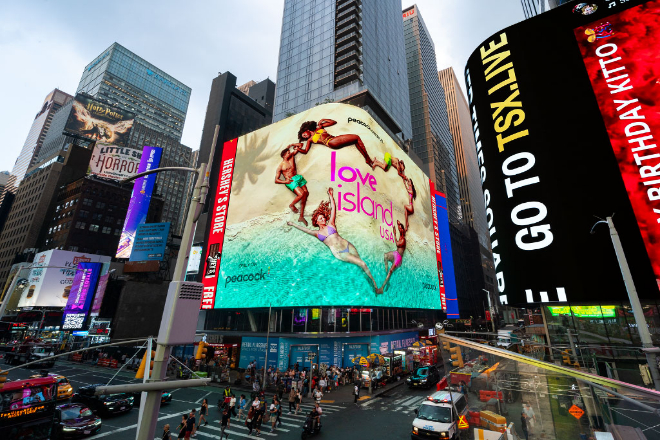
1). Commercial block wall ads
New York Times Square has installed several large outdoor full-color LED screens, among which a giant screen located in the core area of the street is particularly eye-catching.
This screen uses advanced small-pitch technology, with extremely high resolution and clear and delicate pictures. It is used to play various commercial advertisements, city image promotional videos, and live broadcasts of major events.
During holidays and major promotional events, these LED screens attracted a large number of tourists to stop and watch through colorful advertising images and interactive content, greatly enhancing the commercial atmosphere and popularity of Times Square.
LED screens have a strong visual impact and can scroll information 24 hours a day, covering a wider range of people, thereby attracting customers’ attention and increasing traffic.
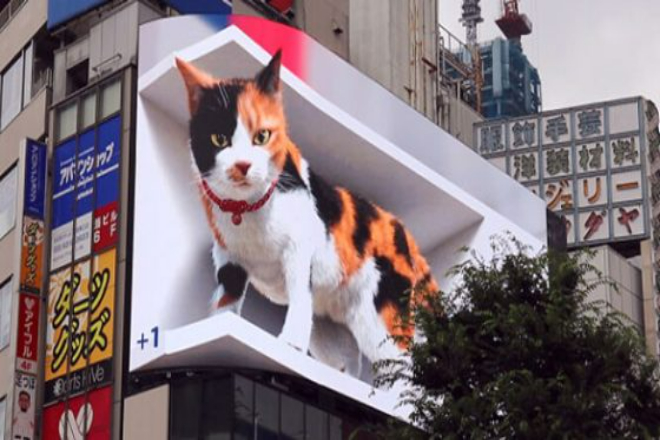
2). Wall advertising of city landmark buildings
The 3D LED display screen in Shinjuku, Japan, is installed on the exterior wall of the building because a kitten advertisement has become a landmark building in Japan.
These LED display screens not only beautify the city buildings but also become an important window to show the city’s image and culture.
They show the unique charm and cultural heritage of the city to citizens and tourists by playing city promotional videos, cultural activities, and other content.
3). Wall advertising at public transportation stations
The application of LED display screens on the walls of public transportation stations has significant advantages.
First, they can update information in real-time, such as train schedules, flight information, bus routes, etc., to improve travel efficiency. Secondly, the high brillo and high contrast of LED display screens make the display content still clearly visible under direct sunlight.
At public transportation stations, LED display screens not only provide passengers with practical travel information but also become an important publicity platform for advertisers.
By playing commercial advertisements, public service advertisements, and other content, LED display screens effectively convey advertising information while beautifying the station environment and enhancing the image of the station.
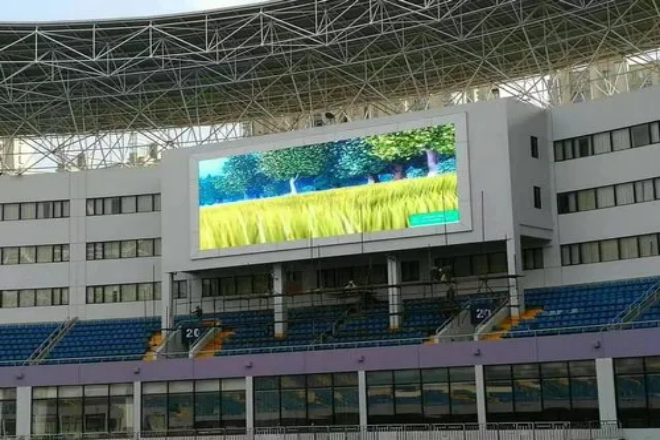
4). Wall advertising in special scenes (such as estadios, concert venues, etc.)
In special scenes such as stadiums and concert venues, the application effect of LED display screens is particularly significant. They can create stunning visual effects and bring immersive viewing or performance experience to the audience.
For example, in sports events, LED screens can play game images, data statistics, and other information in real-time; in concerts, LED screens can play animations, videos, and other content that match the theme of the performance.
These LED screens not only meet the information display needs in specific scenarios but also create a unique atmosphere and experience for the audience through their unique display effects and interactive functions. They make sports events and concerts more vivid and interesting and enhance the audience’s sense of participation and experience.
3. Analysis of the advantages of LED screens in wall advertising
LED screens have shown many significant advantages in wall advertising. The following is a detailed analysis:
1). Outstanding visual effects
- Traditional wall advertising:
Usually produced by spray painting, printing, and other methods, the picture is static, the color is single, and it is easily affected by weather, environment, and other factors, resulting in fading damage and other problems.
- LED screens:
With their high brightness, high definition, dynamic display, and other characteristics, they present a more vivid and realistic picture effect.
As a display unit, the light-emitting diodes of the LED display can emit vivid and bright light, making the picture colorful and high in contrast and maintaining good visibility even in strong sunlight.
2). Convenient content update
2.1). Convenient content update
The LED display supports remote control and real-time updates. Advertisers can remotely manage the display content through computers, mobile phones, and other devices without having to operate them on-site.
This convenient content update method greatly improves the efficiency and flexibility of advertising.
2.2). Meet the need of rapid replacement of advertising content
In commercial activities, advertising content often needs to be quickly replaced according to market changes, promotional activities, and other factors.
The real-time update function of the LED display enables advertisers to adjust the advertising content according to needs anytime and anywhere, ensuring the timeliness and pertinence of advertising information.
3). Interactivity and intelligent trends
3.1). Interactivity and intelligent development trends
With the integration of artificial intelligence and Internet of Things technologies, the interactivity and intelligence level of LED display screens are constantly improving.
For example, through interaction through voice recognition, gesture control, and other methods, the audience can participate in the advertisement, improving user experience and participation.
At the same time, LED display screens can also be connected to other smart devices to achieve remote control and intelligent management.
3.2). Innovative application prospects in future wall advertising
In the future, LED display screens will show broader innovative application prospects in wall advertising.
For example, combined with augmented reality technology, LED display screens can interact with the real environment, blur the boundaries between advertising and audiences, and enhance viewing experience and memory.
In addition, through data analysis and artificial intelligence technology, LED display screens can also realize personalized advertising push according to the characteristics and preferences of the audience and improve the pertinence and effectiveness of advertising.
In summary, LED display screens have become an important part of the modern advertising industry in wall advertising with their outstanding visual effects, convenient content updates, energy-saving and environmental protection characteristics, and interactive and intelligent trends.
With the continuous development of technology and the expansion of innovative application prospects, LED display screens will play a more important role in wall advertising.
4. Challenges and countermeasures faced by LED display screens in wall advertising
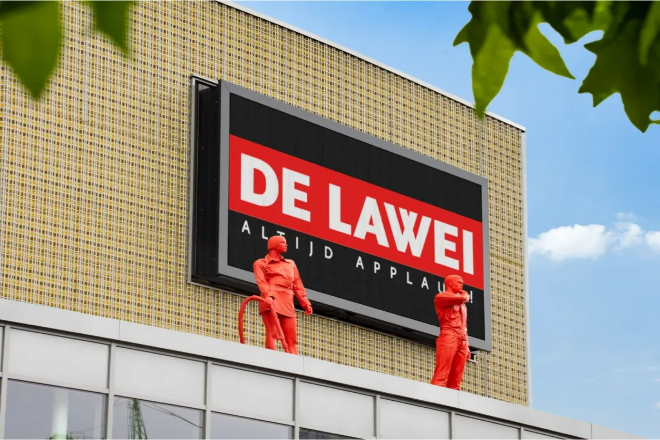
Although the application of LED display screens in wall advertising has significant advantages, it also faces some challenges. The following is an analysis and countermeasures for cost issues, technical difficulties, and regulatory and policy restrictions:
1) Cuestiones de costes
1.1). Cost composition analysis
The cost composition of LED display screens in wall advertising mainly includes the screen body, other accessories, installation and debugging, and subsequent services.
The screen body is the main investment, accounting for about 60% of the total cost, and is specifically spent on the type of LED display screen and the specific parameters of the screen body, such as material, size, thickness, brightness, fuente de alimentación, el consumo de energía, control system, etc.
In addition, the cost of accessories such as audio amplifiers, video processors, cabinets, and wooden box customization fees, as well as the installation environment, wiring time, labor costs, and transportation costs, are also cost expenditures that cannot be ignored.
1.2). Strategic recommendations for reducing costs and improving cost performance
- Reasonable selection of specifications:
Select appropriate LED display specifications according to project requirements and budget to avoid waste caused by excessive investment.
- Optimize procurement channels:
Reduce the cost of raw material procurement through scientific procurement management and cost control, such as bulk procurement and establishing a procurement cost analysis system.
- Fine management:
During the installation and debugging process, rationally plan wiring, reduce unnecessary waste, and strengthen subsequent service management to reduce maintenance costs.
- Select energy-saving products:
LED display screens with energy-saving technology can reduce operating costs, which will help reduce costs in the long run.
2) Dificultades técnicas
2.1). Possible technical difficulties
Pixel discontinuity: Different device compositions may cause pixel discontinuity, affecting the display effect.
Color unevenness: There are differences in color saturation, brightness, and other parameters in different areas, resulting in uneven display effects.
Drive power supply problem: Unstable power supply, too low power, etc., may affect the normal operation of the display.
Communication transmission problem: Long transmission distance, signal interference, etc., may cause screen freeze or delay.
Problema de disipación de calor: High-brightness, high-density LED display screens will generate a lot of heat during operation. If the heat dissipation is poor, it may cause equipment damage or shorten its life.
2.2). Technical innovation and solutions
- Pixel discontinuity:
Use devices from the same batch for splicing to ensure that the hardware devices are completely consistent or adjust at the software level to eliminate discontinuity through precise pixel mapping algorithms.
- Color unevenness:
Select high-quality LED chips to ensure color consistency; perform brightness correction and color balance according to actual conditions; and adjust color values through software.
- Drive power supply problem:
Select a reliable quality driver power supply to ensure its stability and durability; perform power calculation according to the actual needs of the display and select a suitable power supply.
- Communication transmission issues:
Rationally plan the wiring to ensure that the transmission distance does not exceed the maximum limit of the equipment.
Use high-quality transmission wires and interfaces to reduce signal interference; use differential signal transmission technology during transmission to improve anti-interference capabilities.
- Heat dissipation issues:
Install radiators and fans to enhance heat dissipation capabilities; consider heat dissipation structures during design to improve overall heat dissipation effects; control the brightness and use time of the display to reduce the risk of temperature rise.
Conclusión
In summary, the application of LED displays in wall advertising has achieved remarkable results, not only improving the visual effects and attractiveness of advertising but also achieving the goal of rapid content updates.
Por último, si quieres saber más sobre las pantallas LED, Por favor póngase en contacto con nosotros.
